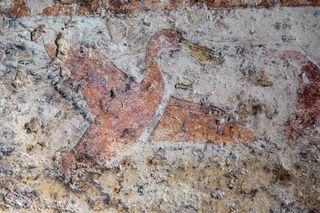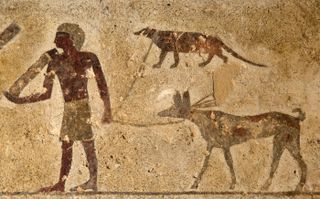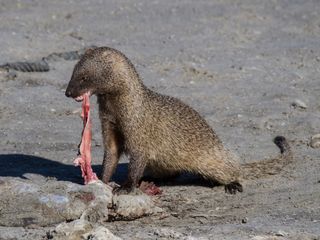In Photos: Ancient Egyptian Tombs Decorated with Creatures
Tomb pelican

A team with Macquarie University's Australian Center for Egyptology is recording the art drawn on the walls of a group of 4,000-year-old tombs at Beni Hassan in Egypt. The artwork shows depictions of numerous creatures, including a pelican, seen here. The tombs were excavated in the 19th century and are being recorded using modern-day technology, a process that is yielding a new view of the drawings that the 19th-century excavators did not see.
[Read full story on the tomb drawings]
Lots of birds

The pelican is part of a larger painting that shows several birds. Before the Macquarie University team recorded the tombs, an Egyptian antiquities ministry team conserved and cleaned them.
A mongoose indeed

This ancient drawing shows a hunter holding the leashes of a dog (bottom) and an Egyptian mongoose (top). This is the only known example of a leashed mongoose drawn by the ancient Egyptians, researchers say. The 19th-century excavators thought that the drawing might be of a leashed mongoose but were not sure; the new recording confirms that it is.
Egyptian hunters

he leashed mongoose and dog are part of a larger scene that includes a group of Egyptian hunters. It's possible that the mongoose was used to help drive birds out of the bushes so that the hunters could more easily kill them.
Meat-eating mongoose

A photo showing an Egyptian mongoose eating a catfish. The animals range in size from 37 to 47 inches (95 to 120 centimeters) in length.
Beni Hassan

The drawings recorded in the tombs include numerous depictions of creatures, particularly birds. It's possible that around 4,000 years ago, when the drawings were created, the environment around Beni Hassan allowed for more bird life to flourish. This photo shows Beni Hassan as it appears today.
Sign up for the Live Science daily newsletter now
Get the world’s most fascinating discoveries delivered straight to your inbox.

Owen Jarus is a regular contributor to Live Science who writes about archaeology and humans' past. He has also written for The Independent (UK), The Canadian Press (CP) and The Associated Press (AP), among others. Owen has a bachelor of arts degree from the University of Toronto and a journalism degree from Ryerson University.
